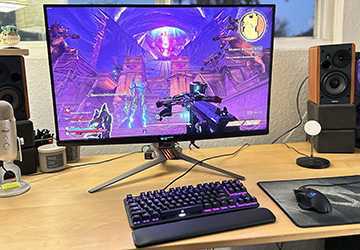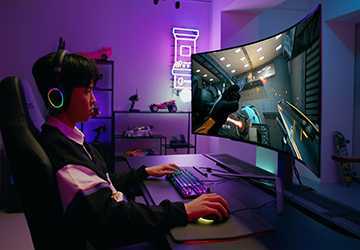What to Look for in Gaming Monitors for Professional Gamers?
In the competitive world of professional gaming, your gear is more than just part of your setup; It is an extension of your skills and a critical factor in determining the game's outcome. Monitors play a central role in this. Therefore, knowing the best gaming monitors and understanding basic gaming monitor features is a must for anyone who wants to achieve a superior gaming experience at the highest level. Let's embark on a comprehensive journey to demystify the best gaming monitors for those serious about gaming.
Resolution and refresh rate: the core of visual excellence
When professional gamers look for the best gaming monitor, the conversation inevitably starts with resolution and refresh rate. In layperson's terms, resolution defines how sharp an object is, while refresh rate indicates how quickly the screen refreshes images. A few years ago, 1080p resolution and 60Hz refresh rate were considered satisfactory. Fast forward to today, and anything less than 1440p resolution and 144Hz refresh rate is all but obsolete in the professional gaming community. These features deliver a noticeably smoother and more detailed gaming experience, providing an advantage in visually intensive games where spotting opponents one second early can make all the difference.

Dive deeper into panel types and response times.
When discussing gaming monitor features, it's essential to consider panel type and response time. There are three main panel types on the market today: IPS, TN, and VA. Each panel type has unique advantages and disadvantages. IPS panels are known for their superior color reproduction and wider viewing angles, but they often have to play catch-up regarding response times. Conversely, TN panels are super fast and better suited for fast-moving gaming but lack color vibrancy. VA panels provide a balance but are often considered a jack of all trades rather than a master of all. For professionals, understanding the types of games they specialize in can help determine the best panel type. Fast response times (typically under five milliseconds) are critical to reducing motion blur and avoiding graphical artifacts, making gameplay more immersive and responsive.
The Compelling Nature of Adaptive Sync Technology in Professional Gaming Monitors
Adaptive sync technologies like Nvidia's G-Sync and AMD's FreeSync have become integral to professional gaming monitors. When the monitor and graphics card are out of sync, screen tearing is a visual threat that can lead to a distracting and confusing gaming experience. G-Sync and FreeSync are designed to eliminate this by ensuring that the monitor's refresh rate dynamically adapts to the graphics card's output; for pros competing in high-stakes tournaments, where even a millisecond matters, ignoring adaptive sync is not an option.
Connectivity: The unsung hero of gaming monitor capabilities
Regarding gaming monitor features, connectivity options are often overlooked but essential. A wealth of connectivity options ensures the versatility and longevity of your professional gaming setup. The best gaming monitors feature a variety of ports, from HDMI and DisplayPort to newer technologies like USB-C. These are not just for connecting to your computer; They also allow you to link various other devices, such as secondary monitors, gaming consoles, and VR headsets, providing a future-proof ecosystem around your primary gaming monitor.
Aspect Ratio: The Underrated Size
One of the most overlooked features of a gaming monitor is the aspect ratio, which directly affects the size of the game world you can see. Traditional monitors typically use a 16:9 aspect ratio, but ultrawide monitors with a 21:9 aspect ratio are becoming increasingly popular. This expanded field of view is helpful in games requiring a wider field. It may provide significant advantages for professionals as it allows you to spot opponents or key elements more effectively.

Built-in speakers: Convenience or necessity?
While hardcore professional gamers often prefer dedicated gaming headsets, having built-in speakers on your monitor can be helpful. The best gaming monitors with high-quality built-in speakers provide a simple audio solution for casual gaming or when headphones are out of reach. Of course, built-in speakers shouldn't be a compromise but an added feature that improves gaming comfort.
Customizable profiles: a game changer
Many of the best gaming monitors now offer the ability to save customizable profiles. If you play different types of games, each with its optimal settings, this is a feature you need to pay attention to. For example, you might want different color settings for a first-person shooter than a strategy game. Customizable profiles allow you to easily switch between these settings, providing a personalized gaming experience tailored to the needs of each game.
Physical Durability: An Investment in Longevity
Physical durability is rarely discussed in professional gaming monitors, but it's essential. The best gaming monitors are not only feature-rich but also durable. Since professional gamers may spend hours in front of a monitor, you must consider the build quality and durability of the monitor you invest in. High-quality materials and superb craftsmanship extend the life of your monitor, making it a proper long-term investment rather than a short-term purchase.
All in all, entering the world of professional gaming monitors requires careful attention to the various features of a gaming monitor. Every aspect is critical, from enabling unparalleled visual clarity through high resolution and refresh rates to ensuring responsiveness across panel types and adaptive sync technology. Add to that the need for versatile connectivity options and comfortable ergonomics, and you'll find that choosing between the best gaming monitors becomes a complex task that requires a nuanced understanding of each feature. So, if you want to advance your professional gaming career, choosing the right monitor isn't just a decision; it's necessary.